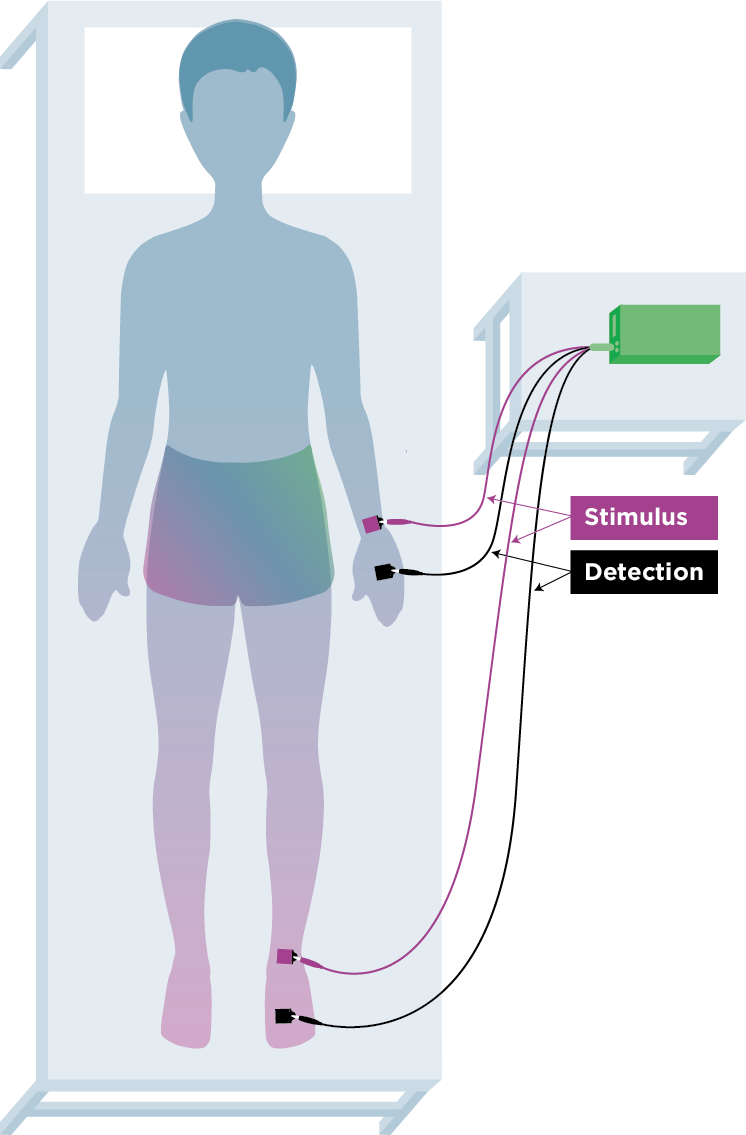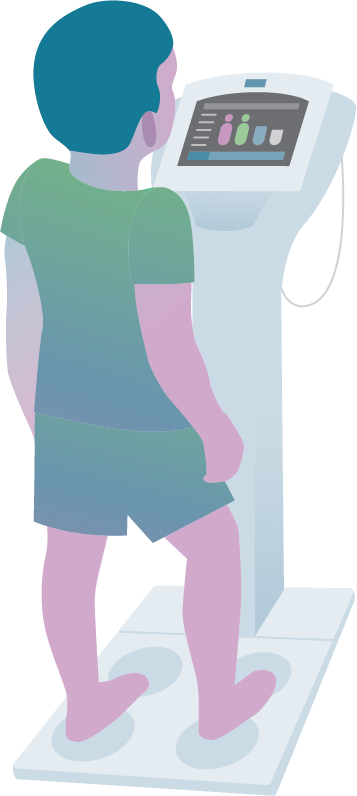Section
5
Assessing Adiposity
Bioelectrical Impedance Analysis (BIA)
The BIA method estimates fat mass and fat-free mass by measuring the impedance or resistance of a small, low voltage electrical current as it travels through water in the body tissues.
From this, prediction equations estimate total FM and FFM. It may be used across all ages, from birth to adulthood.
Procedure
Figure 10: Bioelectrical Impedance Analysis in Supine Position
A variety of BIA systems from different manufacturers are available for use. All systems use a specific number of electrodes (four or eight, depending on the system) that make contact at specific locations on the body where the electrical current that is not felt by the person will be transmitted and then measured as it passes through the body, including “hand-and-foot,” “foot-to-foot,” and “hand-to-hand” systems. Some BIA systems require the participant to be tested in the supine position (Figure 10) and some in the upright position (Figure 11); the former allows for use of the BIA in individuals who cannot stand.
BIA systems may also use a single frequency (50 kHz) or multiple frequencies (frequencies up to 300 kHz) of electrical current, depending on the measurement(s) of interest. Both provide estimates of TBW, although multifrequency BIA allows for the differentiation of TBW into intracellular water (ICW) and extracellular water (ECW) compartments, which is useful to describe fluid shifts and fluid balance and to explore variations in levels of hydration.82,83 Single- and multifrequency systems are also available as multisegmental BIAs to allow for regional measurements of body fat (trunk and limbs separately).
Figure 11: Bioelectrical Impedance Analysis in Upright Position
Given the variation in systems, the manufacturer’s specific guidelines should be carefully followed for testing. In general, measurement of BIA requires that the participant fast for 2 to 3 hours and empty his or her bladder before measurement as well as not participate in strenuous exercise for 12 hours in advance of test to ensure normal hydration. The participant also must have length/height and weight measured according to the previously described anthropometric techniques. Data on age and sex must be available for use in the estimation equations. The participant must have no skin lesions or significant edema at the site of electrode contact and must not be wearing any metal. The skin should be cleaned with alcohol at the site of electrode contact. The electrode surfaces also must be clean and make proper contact with the body part of interest. The body parts in contact with the electrodes should be appropriately positioned so that the arms and legs do not touch the body or each other. Once the electrodes are in place, an electrical current is transmitted through the body and within a few seconds, an impedance value measured in Ohms (unit of electrical resistance) is displayed. The impedance value produced varies by BIA instrument. BIA instruments use built-in manufacturer prediction equations to then estimate body composition variables.
Estimates of Body Fat, Interpretation, and Limitations
The measured value of resistance is used in various prediction equations to estimate TBW, FM, and FFM. The impedance index, which is height2/resistance (length can be substituted for height), is proportional to the volume of total water in the body, which allows for TBW to be estimated using specific equations that include participant weight. FFM is derived from age- and sex-specific equations using the measured impedance as well as weight and height. Using this method, the underlying assumption is that 73% of the body’s FFM is water.84 The difference between body weight and the value derived for FFM is equivalent to total FM. The multisegmental approach measures the impedance of the left and right arms, the left and right legs, and the total body by assuming that the body is made up of a group of cylinders as opposed to a single cylinder. The summed value for the four limbs is subtracted from the total body value to derive the impedance of the trunk. Many other body composition measures may be estimated, depending on the type of system used.
A major limitation of using BIA in children is that the effects of growth and development invalidate several assumptions necessary for the use of BIA. In particular, limb length in children changes frequently with no established pattern. In adults, where trunk and limb lengths are assumed constant, the trunk accounts for ~75% of the body mass and 9% of the total impedance; whereas the limbs account for 25% of the body mass and 91% of the total impedance.85 These assumptions are not met in children. Use of BIA prediction equations is therefore inherently limited in children, particularly during periods of rapid growth. In addition, equations are applicable only to the participants who closely match the study population from which they were derived. Their use in children requires age-, sex-, and race/ethnicity-specific modifications.86-88
Validity and Reliability
The accuracy of body fat measured using BIA is considered to be within 3.5–5.0% when conditions such as ambient temperature, participant hydration status, position of participant, correct electrode placement, use of appropriate equations, and eating and drinking that can affect total body water are regulated.89 Total body water is considered the sum of intracellular water and extracellular water. Children have a higher proportion of their TBW as extracellular fluid, and the extracellular fluid has a higher electrolyte content compared with intracellular fluid. Accordingly, the resistivity measured by BIA in children relative to the amount of FFM will be lower than in adults.90,91
The measurement of TBW and FFM using a tetrapolar system showed a 0.99 test-retest correlation coefficient.92,93 For resistance measurements acquired on 5 successive days, the coefficients of variation for resistance values ranged from 0.9-3.4%, and the average precision was 2%. Test-retest correlation coefficient was 0.99 for a single-resistance measurement, and the reliability coefficient for a single-resistance measurement over 5 days was 0.99.93 Overall, the reliability of BIA has high test-retest correlation and acceptable levels of within-person CVs between 1% and 6%. However, the violation of key assumptions for use of this technology in children suggests that despite high levels of reliability, its validity in children is not strong.
Reference Data
National reference data for children in the U.S. population are not available. However, mean body composition estimates for TBW, FFM, TBF, and %BF based upon NHANES III BIA data provide a descriptive reference for the U.S. population aged 12–80 years.94
Accessibility, Training, and Cost
BIA devices are accessible and portable. Many BIA devices are being marketed, but costs vary widely ($100 to $19,000). Not all of these devices are of research grade or standard, which would be more costly. The tester is required to follow the manufacturer’s procedures manual, and the level of skill required is low.
Acceptability, Participant Burden, and Risk
Acceptability is moderate to high. The method is noninvasive, and risk is low. It requires some participant preparation, such as fasting, that may be difficult in children, but in general, the burden is low. Participants must minimize movement, which is difficult in young children. It is not recommended for participants with a pacemaker or other electrical implants.
Summary
BIA is quick, non-invasive, easy to use, and requires minimal staff training. It is low in cost, generally safe and portable, thus making it appealing for large-scale studies. However, the effects of growth and development on the limb and trunk in children violates key assumptions in using BIA to estimate fat mass, suggesting it may be an inappropriate choice for use in children. Furthermore, BIA use in children of all ages requires age-, sex-, and race/ethnicity-specific predictive equations that may not always be available for the study population of interest.


